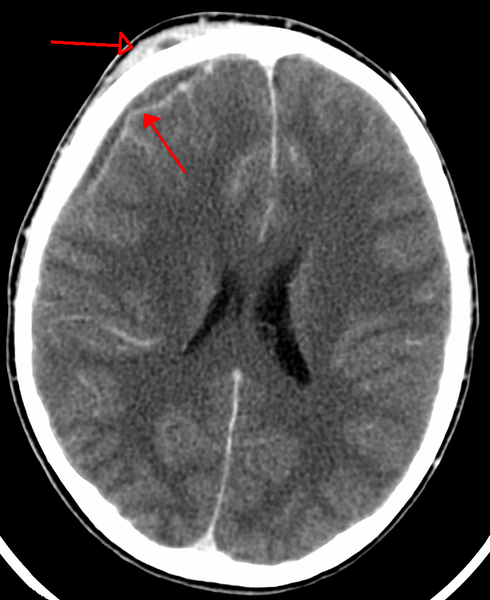Subdural empyema CT
|
Subdural empyema Microchapters |
|
Diagnosis |
|
Treatment |
|
Case Studies |
|
Subdural empyema CT On the Web |
|
American Roentgen Ray Society Images of Subdural empyema CT |
Editor-In-Chief: C. Michael Gibson, M.S., M.D. [1] Associate Editor(s)-in-Chief: João André Alves Silva, M.D. [2]; Anthony Gallo, B.S. [3]
Overview
Head CT scan may be helpful in the diagnosis of subdural empyema. CT scan is secondary to MRI for subdural empyema imaging. Findings on CT scan suggestive of subdural empyema include a crescentic shape, although collection pockets may appear bi-convex. A surrounding membrane that enhances intensely and uniformly following contrast administration is typically identified.[1]
Computed Tomagraphy
Head CT scan may be helpful in the diagnosis of subdural empyema. A contrast-enhanced head CT with axial and coronal places is an accessible and cost-effective imaging study, however the number of false-negative results (approximately 50%) make it a less reliable test than MRI. However, CT scan is the modality of choice in comatose or critically ill patients, where the MRI is not possible or contraindicated.[2] On CT scan, findings suggesting of subdural empyema include a hypodense, crescentic shape over the cerebral convexity, extending over one or both hemispheres or in the inter hemispheric fissure, with a surrounding rim, enhanced by the use of contrast.[3] CT scan may also demonstrate cranial bone involvement and the presence of sinusitis, otitis, or mastoiditis. A mass effect may also be noted.

References
- ↑ Subdural empyema. Radiopaedia.org (2015). http://radiopaedia.org/articles/subdural-empyema Accessed on December 4, 2015.
- ↑ Greenlee JE (2003). "Subdural Empyema". Curr Treat Options Neurol. 5 (1): 13–22. PMID 12521560.
- ↑ Hendaus, Mohammed A. (2013). "Subdural Empyema in Children". Global Journal of Health Science. 5 (6). doi:10.5539/gjhs.v5n6p54. ISSN 1916-9744.